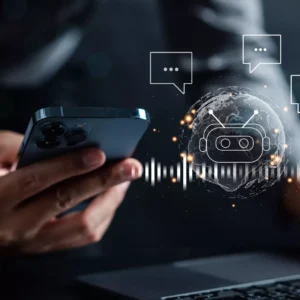
Unified by AI
The New Era of Integrated Communication Systems
Welcome to the era where AI, especially in AI voice over IP (VoIP) systems, is revolutionizing unified communication. In this digital landscape, we’ll explore the remarkable journey through a series of interconnected topics that showcase the boundless possibilities of AI integration.
From optimizing VoIP calls with predictive analytics to adapting to user preferences and ensuring secure encrypted communication, we’ll uncover how AI enhances every facet of our daily interactions. Imagine crystal-clear virtual meetings where AI fine-tunes audio and visual elements in real time. Picture digital assistants seamlessly assisting in chat systems, breaking down language barriers, and personalizing your experience.
But this journey doesn’t end here. We delve into the heart of AI-driven communication analytics and its role in shaping future strategies. AI-powered personalization takes virtual event experiences to the next level by customizing every aspect of your participation.
As we conclude, the question remains: What’s next in the ever-evolving world of AI-integrated communication?
Table of Contents
Optimizing VoIP with AI
In the realm of AI in voice-over IP (VoIP) systems, a remarkable transformation is underway. Imagine your business calls becoming more innovative, efficient, and crystal clear, all thanks to artificial intelligence. With predictive analytics for unified communication platforms, AI anticipates network issues before they disrupt your calls, ensuring seamless connections. But that’s just the beginning.
AI-driven video conferencing enhancements take virtual meetings to a new level, offering real-time adjustments for background noise and lighting, making every participant shine. Virtual assistants, an integral part of digital assistants in communication platforms, can schedule meetings, transcribe discussions, and even translate conversations, breaking down language barriers easily.
But what about security? You’re in safe hands with AI, which fortifies your conversations through AI in communication security, ensuring encrypted and secure communications.
Imagine AI-powered transcription and translation services that bridge language barriers in real time, making global communication a breeze. It doesn’t stop there; AI seamlessly integrates into digital workflows, ensuring efficient collaboration.
By harnessing AI-driven communication analytics, you can gain insights from communication patterns, turning data into valuable strategies. And with AI’s role in virtual event platforms, your online events are set to be more engaging and interactive than ever before.
The future of AI in unified communication solutions is boundless. How will it adapt to user preferences? Let’s dive into Analyzing and adapting to user preferences to find out. How can AI make your virtual meetings even more personalized?
Analyzing and Adapting to User Preferences
Building on the foundation of AI in voice-over IP (VoIP) systems, we embark on a journey of personalized communication experiences. But how does AI do it?
Imagine a world where your communication platform knows your preferences like a trusted friend. With predictive analytics for unified communication platforms, AI analyzes your communication history and adapts to your style. It can suggest the best time for your meetings your preferred contact methods, and even tailor the interface to your liking.
AI-driven assistants, nestled in communication platforms, can predict your needs, helping you before you ask. They anticipate your questions, find suitable files, and even provide real-time language translations, breaking down barriers effortlessly.
But how do we ensure this personalization doesn’t compromise security? AI in communication security plays a pivotal role in safeguarding your preferences, guaranteeing that every tailored experience remains confidential and secure.
As AI revolutionizes communication, the focus shifts to delivering crystal-clear virtual meetings. How will AI make your virtual interactions as vivid as face-to-face encounters?
Delivering Crystal-Clear Virtual Meetings
From personalized preferences, we transition into virtual clarity, where AI in voice-over IP (VoIP) systems takes your online meetings to the next level. But how does AI ensure crystal-clear interactions?
Imagine a scenario where background noise no longer interferes with your conversations. AI-driven enhancements, encompassing AI-driven video conferencing enhancements, automatically adjust audio settings, eliminating distractions and delivering pristine sound quality. Your virtual meetings become as crisp as you were in the same room.
Moreover, AI in unified communication platforms is about more than sound. It’s also about visual excellence. Picture AI fine-tuning lighting and camera settings in real-time, ensuring everyone in the call looks their best, enhancing the quality of AI-driven video conferencing.
But what if you need real-time translations during your meetings? AI has you covered with its prowess in AI for transcription and translation services, breaking down language barriers, and making your conversations genuinely global.
Now, with your meetings at their zenith, what about chat systems? How can we further integrate AI to assist and enhance our interactions? The answer lies in Integrating AI helpers into chat systems, where virtual assistants become your communication allies, offering real-time support and streamlining your messaging experience. How can these AI helpers transform your communication dynamics?
Integrating AI Helpers into Chat Systems
As we revel in the seamless communication made possible by AI, it’s time to explore how virtual assistants transform chat systems. Building on the foundation of crystal-clear virtual meetings, we now discover how these AI helpers take your conversations to new heights.
Picture this: during a chat, AI identifies the tone of the conversation and suggests appropriate responses, enhancing your communication dynamically. With predictive analytics for unified communication platforms, AI predicts your needs, ensuring you never miss a beat in your conversations.
Not only can AI helpers in chat systems assist with text-based communication, but they also offer real-time translations, enabling you to communicate effortlessly across languages. It’s a testament to the power of AI for transcription and translation services.
But the critical question remains: how can these AI helpers ensure your communications stay secure and encrypted? The answer lies in the fortifications provided by AI in communication security, which shields your interactions from prying eyes. How does AI continue to bolster these security measures while revolutionizing our digital communications? This leads us to our next topic: Ensuring encrypted and secure communications.
Ensuring Encrypted and Secure Communications
In our ever-connected world, security is paramount. With AI’s rapid integration into communication systems, the question arises: How does AI maintain the integrity of your conversations, especially after discussing AI helpers in chat systems?
AI, as part of AI in voice-over IP (VoIP) systems, brings encryption to the forefront. It safeguards your messages, calls, and files, ensuring they remain confidential and protected. But what’s more, AI doesn’t just stop at traditional security; it evolves with the changing threat landscape thanks to AI-driven communication analytics. It can proactively identify and thwart potential security breaches.
So, when you chat with AI helpers or engage in virtual meetings, you can rest assured that cutting-edge security measures fortify your data and conversations as part of AI in communication security.
But as AI ensures security, it also plays a vital role in bridging language barriers, allowing you to communicate effortlessly globally. How does it accomplish this feat in real time? Let’s delve into Bridging language barriers in real-time to find out how AI makes global communication a breeze while ensuring the utmost security.
Bridging Language Barriers in Real-Time
After exploring the security features of AI in communication systems, it’s time to embark on a journey through language. How does AI break down linguistic borders in real time?
As part of AI in voice-over IP (VoIP) systems, AI doesn’t just facilitate secure communications; it also facilitates global conversations. Picture a scenario where you’re conversing with someone who speaks a different language. AI comes to your aid with instantaneous translations. Your words are transformed into a language your counterpart understands, transcending the boundaries of communication.
AI-powered transcription and translation services flawlessly convert spoken and written language. The power of AI for transcription and translation services makes the world smaller, creating new possibilities for cross-cultural collaborations.
However, it’s not just about words. AI delves into cultural nuances, helping you avoid misunderstandings and misinterpretations. In our globalized world, this ability to understand and adapt to diverse cultures plays a pivotal role in making international communications a breeze.
With language barriers melting away, the focus shifts to seamless collaboration. How can AI be the glue that binds diverse digital workflows together? This leads us to our next topic: Seamlessly connecting digital workflows. How does AI revolutionize how we work and communicate in the digital age?
Seamlessly Connecting Digital Workflows
In exploring AI’s transformative role in communication, we’ve travelled from enhancing virtual meetings to transcending language barriers. But how does AI integrate into the digital workflows that define modern businesses and collaborations?
AI in voice-over IP (VoIP) systems is the linchpin in this journey. Imagine your communication system being more than just calls and messages; it becomes a dynamic hub streamlining your work process. AI is the conductor orchestrating this symphony, ensuring that every piece of your digital workflow harmonizes seamlessly.
Digital workflows are often complex, but AI simplifies the intricacies. It automates routine tasks, schedules meetings, and categorizes messages based on priority and relevance. This integration is at the heart of AI in workflow integration, making your work more efficient and productive.
As AI learns from your behaviour, it anticipates your needs, suggesting actions and offering solutions before you ask. It’s like having a virtual assistant constantly at your side, enhancing your workflow efficiency and productivity, an integral part of AI-driven communication analytics.
But how does this affect your business strategy? How do you gain insights from these communication patterns? Let’s dive into Gaining insights from communication patterns to understand how AI can turn data into strategies and take your business to the next level.
Gaining Insights from Communication Patterns
Building on the seamless integration of AI into digital workflows, it’s time to explore the treasure trove of insights hidden in your communication data. How does AI turn your conversations into actionable strategies?
As part of AI in voice-over IP (VoIP) systems, AI isn’t just about improving calls; it’s about extracting valuable data from your interactions. AI-driven communication analytics dives deep into your messages, meetings, and calls. It detects patterns, identifies trends, and provides invaluable insights into how your team communicates and collaborates. This is the heart of AI-driven communication analytics.
By leveraging these valuable insights, you can confidently make decisions backed by data, paving the way for success. Are certain team members more engaged during video conferences? Do specific phrases lead to better outcomes? These questions can guide your business strategy, ensuring that every communication enhances productivity and efficiency.
But as we gain insights into communication patterns, a new horizon opens. How can AI elevate your virtual event experiences? What if your online events were more engaging, interactive, and immersive than ever before? This leads us to our next topic: Elevating virtual event experiences. How does AI redefine how we participate in and host virtual events, making them more captivating and impactful?
Elevating Virtual Event Experiences
After discovering how AI transforms communication data into actionable insights, let’s explore how it revolutionizes virtual events. How does AI redefine the way we participate and host online gatherings?
In the world of AI in voice-over IP (VoIP) systems, the concept of virtual events takes on a new dimension. Imagine attending an online conference or seminar where AI personalizes your experience. It knows your interests, suggests relevant sessions, and connects you with like-minded participants. AI makes your virtual event not just informative but also engaging, a vital part of the Future of AI in unified communication solutions.
But AI doesn’t stop at personalization. It ensures the event’s technical aspects run smoothly. AI-driven video enhancements make every presenter look and sound their best, enhancing the AI-driven video conferencing enhancements.
Moreover, AI seamlessly translates the proceedings in real time, breaking down language barriers and making international events more inclusive and accessible. This is where the capabilities of AI for transcription and translation services shine.
As your virtual events become more engaging and accessible, the question emerges: How will AI continue to evolve and redefine the landscape of AI-integrated communication? What’s next in the evolution of these transformative technologies? This leads us to our final topic: Charting the evolution of AI-integrated communication.
Charting the Evolution of AI-Integrated Communication
After an exhilarating journey through the impact of AI on unified communication, it’s time to ponder the future. How will AI continue shaping how we connect and collaborate in the coming years?
As we’ve seen in the context of AI in voice-over IP (VoIP) systems, AI has seamlessly integrated into our communication. It has evolved to deliver crystal-clear virtual meetings, predict our preferences, and secure our conversations. But the question remains: What’s next?
The future of AI-integrated communication is about more than just refining existing features. It’s about redefining the very nature of how we communicate. Virtual event experiences will become more immersive and interactive as AI personalizes every aspect. But will AI transform the workplace into a virtual environment, making telecommuting feel like being in the office?
The role of AI in language translation will continue to expand. Can we expect AI to break down language barriers even more effectively, enabling real-time, natural conversations between people who speak different languages?
Moreover, how will AI adapt to changing business needs and technological advancements? The future could bring integration with augmented reality, holographic meetings, or even more advanced forms of virtual reality. But what other possibilities await in the ever-evolving landscape of AI-integrated communication?
In the quest for these answers, we invite you to explore how AI’s relentless evolution promises a future of seamless, intelligent, and incredibly effective communication. How will you embrace and leverage these advancements to lead your industry into the future of unified communication?
Conclusion: Paving the Path Forward with AI-Integrated Communication
In this journey through AI in unified communication, we’ve witnessed a revolution unfolding. AI in voice-over IP (VoIP) systems has not only optimized the quality of our calls but also the way we communicate, collaborate, and connect with the world.
From predictive analytics that anticipates network issues to AI-driven enhancements for crystal-clear virtual meetings, we’ve marvelled at the transformation in our communication experiences. Digital assistants have become our allies, guiding us through chat systems and providing real-time translations, ensuring no language barrier remains unbroken.
AI secures our conversations through encryption and helps us gain insights from communication patterns, turning data into strategies for the future. Virtual events are no longer just gatherings; they’re immersive experiences, personalized to each participant, with AI as the conductor.
But what lies beyond? The future is like a blank canvas, eagerly waiting to be painted with the innovative strokes of AI. Virtual workplaces, even more advanced language translations, and integration with augmented and virtual realities may await us.
AI-integrated communication is a journey without an endpoint. It’s an ever-evolving landscape that promises to redefine how we connect and collaborate. So, how will you embrace the power of AI in your unified communication solutions? The future is yours to chart, and with AI as your ally, the possibilities are boundless.

Arindam Roy
An Automation Consultant with 25+ years of IT Experience
Forbes Articles related to AI usage in the Telecom Sector:

















